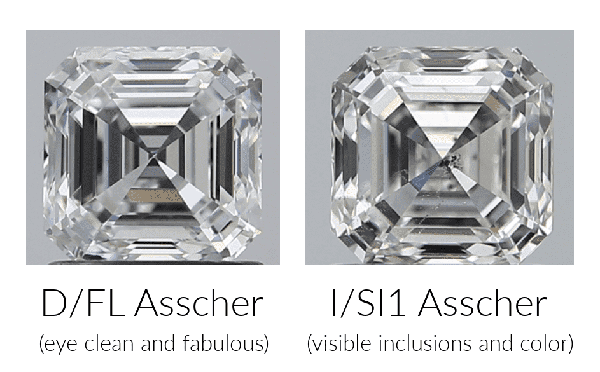Diamond Clarity Simplified | Rare Carat
What is Clarity?
Most of us diamond lovers are familiar with diamond evaluation based on the 4 C’s; Clarity, Cut, Color, and Carat weight. While each category is important in its own right, clarity is essential in overall diamond grading and especially diamond pricing. Sometimes one clarity call in either direction, higher or lower, could mean the difference of thousands of dollars (seriously!). Clarity is just the absence of inclusions (internal) or blemishes (external). A blemish only affects the diamond’s clarity grade if the diamond is flawless, and most of us normal people will probably never even see a flawless diamond anyway, so that’s fine. Internally, and usually on a microscopic level, are the clarity characteristics we care about.
The Different Clarity Grades
Pretty much all natural diamonds have inclusions of some kind (besides the uber fab flawless ones previously mentioned). Most of these inclusions we will never see with the naked eye, but they do help us identify the stone. Actually, diamonds are a lot like snowflakes in that way - no two are the same. How cool is that??! Your diamond is uniquely yours… which is totally just another reason to love diamonds even more. Gemologists judge these inclusions based on 5 factors: size, number, location, relief (how obvious), and nature (what it actually is - fracture, crystal, etc.). These specific factors determine where the diamond falls within the clarity grading scale, which looks something like this:

Flawless is clearly the most expensive tier, and rightfully so. These diamonds are extremely rare… I mean really, anything truly naturally flawless is extremely rare in general, but even more so in a diamond. An Internally flawless grade is also incredible, just has some minor surface blemishes that can be fixed (I would also probably take this as a compliment in real life). VVS1 and VVS2 have inclusions but you’ll never see them without a microscope… and even then, they will be minute. VS1 and VS2 diamonds contain minor inclusions that are slightly larger but can still be difficult to see without some kind of magnification. The SI range is where eye visible inclusions really begin. An SI1 diamond might look pretty good, and most of these are definitely acceptable, so don’t be afraid of it, just be aware that not all look the same. From this point on, inclusions just get bigger and darker and more numerous (we still love you). Sadly, inclusions at this level (SI2) are probably fairly distracting on the finger and not really worth investing in.

Which Grade Should I Choose?
Really and truly, if clarity is a priority for you in diamond buying, any diamond with a V in the grade is ideal (VVS, VS). If clarity is not as important to you as size is, then go with an SI1 and put the extra money towards a bigger rock! (Compromising a little on color is also a good way to finagle for larger sizes.) It is very important to make sure you check the diamond first for any particularly distracting inclusions before you commit though! Trust your eyes, they will tell you what you like.
This is also the same grading scale that will be on any GIA diamond report (which you definitely want when purchasing a diamond). You will get the official clarity call annnnnd a plot of where and what inclusions your diamond has (in sizes larger than 1ct.). Additionally, there are treatments that are designed to improve the clarity (and color) of diamonds but remember any treatment, if detectable, will decrease the value of the stone and may affect the durability.

No matter which clarity grade you choose to go with, the gemologists here can help tell you if it’s going to be eye clean or not. Just give us a shout in the chat bubble for help! Start your search HERE

